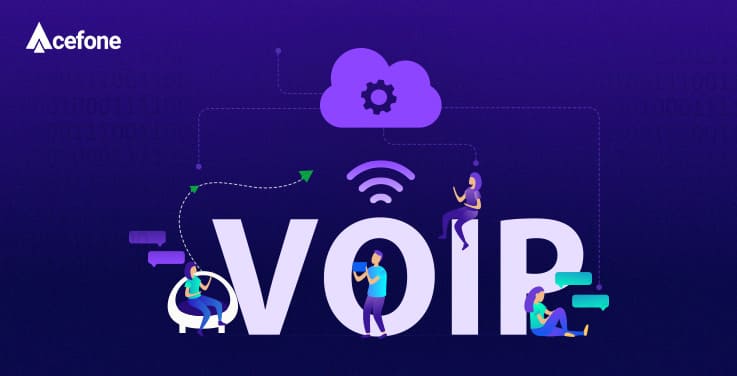Cloud-based VoIP services have become an essential part of business communications.
VoIP, or Voice over Internet Protocol is a VoIP phone system that handles inbound and outbound calls via an Internet connection. VoIP solutions are foundational to modern inbound call center operations, enabling users to make and receive voice calls through smart devices like computers, mobile phones, and so forth
VoIP is a technology used by both consumers and businesses. In fact, modern businesses of all scales and sizes prefer VoIP based services over traditional phone systems.
The reason is quite simple— Being able to leverage capabilities such as auto-attendants, call routing, call forwarding, DND, Interactive Voice Response (IVR) systems, etc. without any extravagant expenses.
These features boost productivity by allowing agents to answer calls from anywhere using their personal devices and the Internet. Thus, they are well-suited for both in-office and remote working models.
VoIP solutions are a no-brainer for businesses, but they have their own set of limitations. The good news is that your provider can solve these issues for you, and you won’t need to hire a support team.
This blog shares the seven most common VoIP problems and ways you can fix them.
Network and LAN issues
This is one of the most common problems that can arise while using VoIP solutions.
Network issues involve problems between personal computers or the equipment (such as router or modem) that connects them with the Internet. For instance, the router could be incompatible or malfunctioning.
For efficient VoIP performance, you need a router that prioritizes calls over less critical network traffic. This method of prioritizing network traffic is also known as Quality of Service or QoS.
How to fix these network issues?
- Reset your router and computer to check the wiring.
- Upgrade your router.
- Make sure you configure your router for VoIP prioritization.
- Try disabling the SIP application layer gateway.
Choppy audio
A choppy audio call refers to a broken voice or missing words when both parties connect on a call.
The most common reason behind choppy audio is packet loss and insufficient bandwidth.
It doesn’t necessarily mean you have a slow Internet connection or there is too much network traffic. It simply means that there is another application consuming more bandwidth at the same time.
How can you improve audio quality?
- Turn off all the devices connecting to the network.
- Test your bandwidth speed.
- Check if there are any other applications running at the same time.
- Check for any malware by installing anti-malware software.
- Configure the router’s QoS to prioritize voice application.
Echo
Echo occurs when you can hear your voice repeat over a phone call.
It mostly exists in traditional phone systems but goes unnoticed due to low latency and echo cancellation. There are mainly three reasons why an echo occurs in a VoIP call: outdated device, headset lag or network latency.
Note- The echo is directly proportional to network latency. As the latency increases, echo increases accordingly.
How do you reduce echo during calls?
- Place your router away from the computer’s monitor.
- Ensure the cables are not too long and protected from moisture.
- Disconnect any caller ID devices connected to your router.
- Replace your calling equipment if it’s too old.
- Cover the mouthpiece of your phone.
Jitter or data packet loss
Jitter occurs when there is a variation in the arrival time of data packets.
The jitter buffer collects data packets and constantly sends them to the receiver so they can have a clear conversation.
However, when the jitter buffer is wrongly configured, it results in dropped packets and low-quality voice calls.
Here’s how you can fix this problem
- Check if the chords are connected to the router properly
- Update your software and restart the application
- Upgrade your hardware
- Check your wifi connection
- Address the bandwidth configuration
- Install anti-virus to check the network security vulnerability
Calls go to voicemail
You could face serious issues if all your calls start going to cloud voice mail. You will be unable to assist callers and your customer service delivery will be severely affected. Callers will be left disappointed without any resolution and ultimately, your reputation will get affected.
Here’s how you can solve the issue before it snowballs into a bigger problem:
- Ensure that your phone is registered with the VoIP service provider
- Check if your phone is on Do Not Disturb (DND) mode
- Review your call forwarding configuration and verify that your phones are connected
Latency
Latency refers to the time taken for audio data to move from a phone or a computer to your headphones. In simpler terms, latency is the delay in audio that callers usually experience.
The amount of lag depends on your network, device and headsets. To avoid latency, ensure that your device is updated and connected correctly.
Some ways to fix latency are:
- Check your bandwidth
- Disconnect unused devices
- Update your hardware and router
- Check the quality of the service setting
- Consult with your service provider
The call connects with no sound
If “can you hear me?” is a statement you frequently repeat during your calls, then chances are that the voice packets are only travelling in one direction.
It could be a one-way audio call where one person can’t hear the other or no audio call where both the people on a call are unable to hear each other.
Such issues happen when firewalls block RTP packets.
To fix them:
- Check your equipment to eliminate faulty phone and handset earpieces
- Simplify the LAN connection and VoIP device connected
- Reconfigure your LAN network

Conclusion
VoIP phone system is the present and future of business communication. It makes it easier for employees, management and associates to collaborate internally and communicate with clients.
Clients can connect with your support team faster, receiving a better customer experience and sticking with your business for longer.
While VoIP has its own set of problems, they are easy to resolve without any external help.
At Acefone, we offer the best VoIP phone service along with excellent customer support that is sure to help your business run without any discontinuity.
Contact us at 1888-859-0450 or drop an email at [email protected].














